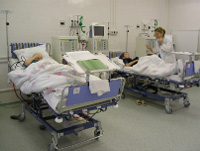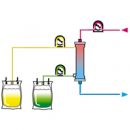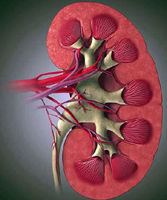Widespread use of peritoneal dialysis significantly facilitated the life of patients suffering from Uremia. The dialysis mechanism is based on the use of the physiological properties of the peritoneum, which is a semi-permeable membrane, blood filtering substance.
Content
Concept of peritoneal dialysis
Diagnosis «uremia» (Translated from Greek. Watering in the blood) for a long time sounded as a sentence for people suffering from renal failure. Only in the middle of the 20th century it became possible to salvation and social rehabilitation. Currently, in addition to transplantation, there are two main types of replacement of broken renal functions - extracorporeal, which is called hemodialysis and intracorporal - peritoneal dialysis.
Dialysis (from Greek. Dialysis - separation) - the release of colloidal solutions from low molecular weight solutions dissolved in them with semi-permeable membranes. In our country, it is mainly used by hemodialysis, a method in which blood is cleaned with the help of an artificial kidney, «Filtering» Through artificial semipermeable membrane. In many cases, however, it is preferable to peritoneal dialysis when purification occurs directly in the patient's abdominal cavity.
Indications for the use of peritoneal dialysis are considered:
- Chronic renal failure
- Acute renal failure
- Prevention of progression of accumulation of toxins in destructive processes in the abdominal cavity (peritonitis, pancreatitis)
- severe stagnant heart failure
- Acute poisoning of barbiturates, sleeping pills and sedative means of non-bairceturic row, aniline and nitrobenzene, chlorinated hydrocarbons, phosphorodorganic compounds
Contraindications for peritoneal dialysis
However, there are both restrictions on the use of peritoneal dialysis. Contraindications to the formulation of the catheter are cavalry peritonitis, the presence of drainage in the abdominal cavity, inflammatory processes on the front abdominal wall. The effectiveness of peritoneal dialysis is low if the volume of the abdominal cavity is reduced due to adhesions, tumors or large polycystic kidneys. For high and fat people with a complete absence of urine preferably hemodialysis.
The mechanism of action of peritoneal hemodialysis
 The first attempts to help patients with Uremia through peritoneal dialysis were made since the beginning of the century, but he received a rapid development in the 70s. Currently, 16 percent of patients with chronic renal failure are in the world in peritoneal dialysis.
The first attempts to help patients with Uremia through peritoneal dialysis were made since the beginning of the century, but he received a rapid development in the 70s. Currently, 16 percent of patients with chronic renal failure are in the world in peritoneal dialysis.
Why the abdominal cavity was chosen for dialysis? The answer is very simple. It seems that the nature itself is created as a reserve body of purification. The peritonean is the biggest serous shell in the human body.
The mechanism of action of peritoneal dialysis is based on the fact that the peritoneum behaves like a semi-permeable membrane, filtering substances from blood. The rate of ultrafiltration, removal of water from the body, with peritoneal dialysis is regulated by a change in glucose concentration in dialysis solution. The higher the content of glucose in the solution, the more ultrafiltration.
The essence of this method is that the dialysis solution through the catheter is introduced into the abdominal cavity and left for 5-6 hours. During this time, an equilibrium is achieved at the concentration of slags in the blood of the patient and dialysis. The patient at the same time can engage in its usual activities. Then dialysate merges and replaced with fresh solution. Replacement produce 4-5 times a day daily and constantly.
For peritoneal dialysis, a system consisting of two bags with solutions, two-dimensional cylinders at the inlet and at the outlet of the abdominal cavity and the container for the drainage. This method allows to some extent replace the cleaning function of the kidneys. A person with inactive kidneys or even without them passing regularly procedure of peritonial hemodialysis can live for years.
Advantages of peritoneal dialysis
Depending on the ability to balance the osmotically active substances, the membranes with a fast, slow and average glucose absorption speed are distinguished. Fortunately, most people have peritoneum with an average absorption rate, best suitable for permanent outpatient peritoneal dialysis. Extremes, as always, undesirable. By the way, before the start of dialysis, the type of peritoneum of this patient cannot be determined.
With peritoneal dialysis, the biological membrane is used - peritoneum, which eliminates the problems. Maybe therefore, when carrying out peritoneal dialysis, patients noted the best preservation of the residual function of the kidneys, than in hemodialysis patients. This method is recommended to people with a significant residual kidney function and those who have the restoration of the function is still possible.
With peritoneal dialysis, it is possible to achieve practically normalization of water exchange and nutrition. This method allows patients to live with very small restrictions in a diet and water mode.
Peritoneal dialysis can be held at home under periodic patronage of nurses. A person can live in a family, lead an active lifestyle, children have the opportunity to go to school.
Obviously, technically peritoneal dialysis is much easier than hemodialysis, cheaper, more accessible to patients and, most importantly, more physiological.









